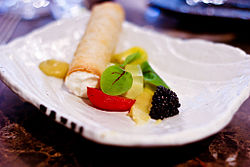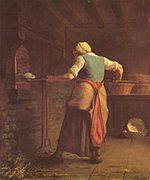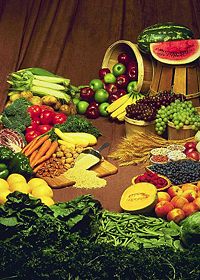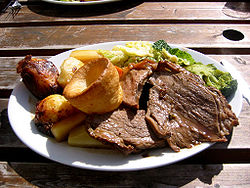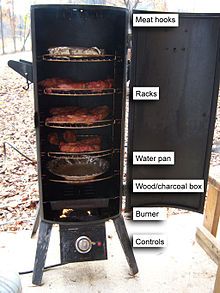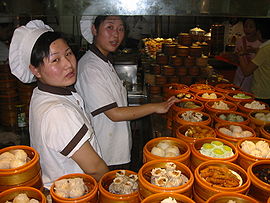- Cooking
-
This article is about the preparation of food by heating. For food preparation generally, see Food preparation.
Cooking is the process of preparing food by use of heat. Cooking techniques and ingredients vary widely across the world, reflecting unique environmental, economic, and cultural traditions. Cooks themselves also vary widely in skill and training. Cooking can also occur through chemical reactions without the presence of heat, most notably as in Ceviche, a traditional Spanish dish where fish is cooked with the acids in lemon or lime juice. Sushi also utilizes a similar chemical reaction between fish and the acidic content of rice glazed with vinegar.
Preparing food with heat or fire is an activity unique to humans, and some scientists believe the advent of cooking played an important role in human evolution.[1] Most anthropologists believe that cooking fires first developed around 250,000 years ago. The development of agriculture, commerce and transportation between civilizations in different regions offered cooks many new ingredients. New inventions and technologies, such as pottery for holding and boiling water, expanded cooking techniques. Some modern cooks apply advanced scientific techniques to food preparation.[2]
Contents
History
See also: Culinary artsThere is no clear evidence as to when the practice of cooking food was first conceived. Most anthropologists believe that cooking fires began only about 250,000 years ago, when hearths started appearing.[3] Primatologist Richard Wrangham suggested that cooking was invented as far back as 1.8 million to 2.3 million years ago.[4][5] Other researchers believe that cooking was invented as late as 40,000 or 10,000 years ago. Evidence of fire is inconclusive, as wildfires started by lightning-strikes are still common in East Africa and other wild areas, and it is difficult to determine when fire was first used for cooking, as opposed to just being used for warmth or for keeping predators away.
Ingredients
Most ingredients in cooking are derived from living organisms. Vegetables, fruits, grains and nuts as well as herbs and spices come from plants, while meat, eggs, and dairy products come from animals. Mushrooms and the yeast used in baking are kinds of fungi. Cooks also use water and minerals such as salt. Cooks can also use wine or spirits.
Naturally occurring ingredients contain various amounts of molecules called proteins, carbohydrates and fats. They also contain water and minerals. Cooking involves a manipulation of the chemical properties of these molecules.
Carbohydrates
Main article: CarbohydratesCarbohydrates include the common sugar, sucrose (table sugar), a disaccharide, and such simple sugars as glucose (from the digestion of table sugar) and fructose (from fruit), and starches from sources such as cereal flour, rice, arrowroot, and potato. The interaction of heat and carbohydrate is complex.
Long-chain sugars such as starch tend to break down into simpler sugars when cooked, while simple sugars can form syrups. If sugars are heated so that all water of crystallisation is driven off, then caramelization starts, with the sugar undergoing thermal decomposition with the formation of carbon, and other breakdown products producing caramel. Similarly, the heating of sugars and proteins elicits the Maillard reaction, a basic flavor-enhancing technique.
An emulsion of starch with fat or water can, when gently heated, provide thickening to the dish being cooked. In European cooking, a mixture of butter and flour called a roux is used to thicken liquids to make stews or sauces. In Asian cooking, a similar effect is obtained from a mixture of rice or corn starch and water. These techniques rely on the properties of starches to create simpler mucilaginous saccharides during cooking, which causes the familiar thickening of sauces. This thickening will break down, however, under additional heat.
Fats
Types of fat include vegetable oils and animal products such as butter and lard. Fats can reach temperatures higher than the boiling point of water, and are often used to conduct high heat to other ingredients, such as in frying or sautéing.
Proteins
Edible animal material, including muscle, offal, milk, eggs and egg whites, contains substantial amounts of protein. Almost all vegetable matter (in particular legumes and seeds) also includes proteins, although generally in smaller amounts. Mushrooms have high protein content. Any of these may be sources of essential amino acids. When proteins are heated they become denatured (unfolded) and change texture. In many cases, this causes the structure of the material to become softer or more friable - meat becomes cooked and is more friable and less flexible. In some cases, proteins can form more rigid structures, such as the coagulation of albumen in egg whites. The formation of a relatively rigid but flexible matrix from egg white provides an important component of much cake cookery, and also underpins many desserts based on meringue.
Vitamins and minerals
Main articles: Vitamins and MineralsVitamins are materials required for normal metabolism but which the body cannot manufacture itself and which must therefore come from soil. Vitamins come from a number of sources including fresh fruit and vegetables (Vitamin C), carrots, liver (Vitamin A), cereal bran, bread, liver e ( B vitamins), fish liver oil (Vitamin D) and fresh green vegetables (Vitamin K). Many minerals are also essential in small quantities including iron, calcium, magnesium and sulphur; and in very small quantities copper, zinc and selenium. The micronutrients, minerals, and vitamins[6] in fruit and vegetables may be destroyed or eluted by cooking. Vitamin C is especially prone to oxidation during cooking and may be completely destroyed by protracted cooking.[7]
Water
Cooking often involves water, which is frequently present in other liquids, both added in order to immerse the substances being cooked (typically water, stock or wine), and released from the foods themselves. Liquids are so important to cooking that the name of the cooking method used is often based on how the liquid is combined with the food, as in steaming, simmering, boiling, braising, and blanching. Heating liquid in an open container results in rapidly increased evaporation, which concentrates the remaining flavor and ingredients - this is a critical component of both stewing and sauce making.
Methods
There are very many methods of cooking, most of which have been known since antiquity. These include baking, roasting, frying, grilling, barbecuing, smoking, boiling, steaming and braising. A more recent innovation is microwaving. Various methods use differing levels of heat and moisture and vary in cooking time. The method chosen greatly affects the end result. Some foods are more appropriate to some methods than others. Some major hot cooking techniques include:
- Roasting
- Roasting - Barbecuing - Grilling - Rotisserie - Searing
- Baking
- Baking - Baking Blind - Broiling - Flashbaking
- Boiling
- Boiling - Blanching - Braising - Coddling - Double steaming - Infusion - Poaching - Pressure cooking - Simmering - Steaming - Steeping - Stewing - Vacuum flask cooking
- Frying
- Frying - Deep frying - Hot salt frying - Hot sand frying - Pan frying - Pressure frying - Sautéing - Stir frying
- Smoking
- Smoking
Food safety
When heat is used in the preparation of food, it can kill or inactivate potentially harmful organisms including bacteria and viruses.
The effect will depend on temperature, cooking time, and technique used. The temperature range from 41 °F to 135 °F (5 °C to 57 °C) is the "Danger zone (food safetymed to be far less likely to harbor bacteria.[8] This has been debated, and some research has shown wooden boards are far better.[9] Washing and sanitizing cutting boards is highly recommended, especially after use with raw meat, poultry, or seafood. Hot water and soap followed by a rinse with an antibacterial cleaner (dilute bleach is common in a mixture of 1 tablespoon per gallon of water, as at that dilution it is considered food safe, though some professionals choose not to use this method because they believe it could taint some foods), or a trip through a dishwasher with a "sanitize" cycle, are effective methods for reducing the risk of illness due to contaminated cooking implements.[10]
Effects on nutritional content of food
Proponents of Raw foodism argue that cooking food increases the risk of some of the detrimental effects on food or health. They point out that the cooking of vegetables and fruit containing vitamin C both elutes the vitamin into the cooking water and degrades the vitamin through oxidation. Peeling vegetables can also substantially reduce the vitamin C content, especially in the case of potatoes where most vitamin C is in the skin.[11] However, research using an artificial gut has shown that in the specific case of carotenoids a greater proportion is absorbed from cooked vegetables than from raw vegetables.[7]
Baking, grilling or broiling food, especially starchy foods, until a toasted crust is formed generates significant concentrations of acrylamide, a possible carcinogen.[12]
Cooking dairy products may reduce a protective effect against colon cancer. Researchers at the University of Toronto suggest that ingesting uncooked or unpasteurized dairy products (see also Raw milk) may reduce the risk of colorectal cancer.[13] Mice and rats fed uncooked sucrose, casein, and beef tallow had one-third to one-fifth the incidence of microadenomas as the mice and rats fed the same ingredients cooked.[14][15] This claim, however, is contentious. According to the Food and Drug Administration of the United States, health benefits claimed by raw milk advocates do not exist. "The small quantities of antibodies in milk are not absorbed in the human intestinal tract," says Barbara Ingham, Ph.D., associate professor and extension food scientist at the University of Wisconsin-Madison. "There is no scientific evidence that raw milk contains an anti-arthritis factor or that it enhances resistance to other diseases."[16]
Several studies published since 1990 indicate that cooking muscle meat creates heterocyclic amines (HCAs), which are thought to increase cancer risk in humans. Researchers at the National Cancer Institute found that human subjects who ate beef rare or medium-rare had less than one third the risk of stomach cancer than those who ate beef medium-well or well-done.[17] While eating meat raw may be the only way to avoid HCAs fully, the National Cancer Institute states that cooking meat below 212 °F (100 °C) creates "negligible amounts" of HCAs. Also, microwaving meat before cooking may reduce HCAs by 90%.[17] Nitrosamines, present in processed and cooked foods, have also been noted as being carcinogenic, being linked to colon cancer.
Research has shown that grilling or barbecuing meat and fish increases levels of carcinogenic Polycyclic aromatic hydrocarbons (PAH). However, meat and fish only contribute a small proportion of dietary PAH intake - most intake comes from cereals, oils and fats.[18] German research in 2003 showed significant benefits in reducing breast cancer risk when large amounts of raw vegetable matter are included in the diet. The authors attribute some of this effect to heat-labile phytonutrients.[19]
Heating sugars with proteins or fats can produce Advanced glycation end products ("glycotoxins").[20] These have been linked to ageing and health conditions such as diabetes.
Science
The application of scientific knowledge to cooking and gastronomy has become known as molecular gastronomy. This is a subdiscipline of food science. Important contributions have been made by scientists, chefs and authors such as Herve This (chemist), Nicholas Kurti (physicist), Peter Barham (physicist), Harold McGee (author), Shirley Corriher (biochemist, author), Heston Blumenthal (chef), Ferran Adria (chef), Robert Wolke (chemist, author) and Pierre Gagnaire (chef).
Chemical processes central to cooking include the Maillard reaction - a form of non-enzymatic browning involving an amino acid, a reducing sugar and heat.
Home-cooking vs. factory cooking
Although cooking has traditionally been a process carried out informally in a home or around a communal fire, cooking is also often carried out outside of personal quarters, for example at restaurants, or schools. Bakeries were one of the earliest forms of cooking outside the home, and bakeries in the past often offered the cooking of pots of food provided by their customers as an additional service. In the present day, factory food preparation has become common, with many "ready-to-eat" foods being prepared and cooked in factories and home cooks using a mixture of scratch made, and factory made foods together to make a meal.
"Home-cooking" may be associated with comfort food, and some commercially produced foods are presented through advertising or packaging as having been "home-cooked", regardless of their actual origin.
See also
- Carry over cooking
- Control of fire by early humans
- Cooker
- Cooking weights and measures
- Cuisine
- Culinary arts
- Culinary profession
- Cooking school
- Dishwashing
- Food and cooking hygiene
- Food industry
- Food preservation
- Food writing
- Foodpairing
- Gourmet Library and museum
- High altitude cooking
- International food terms
- List of food preparation utensils
- List of recipes
- Nutrition
- Recipe
- Scented water
- Spices
- Staple (cooking)
References
- ^ Christine Dell'Amore in Chicago (February 13, 2009). "Cooking Gave Humans Edge Over Apes?". National Geographic News. http://news.nationalgeographic.com/news/2009/02/090213-human-diet-cooking.html.
- ^ W. Wayt Gibbs and Nathan Myhrvold. "A New Spin on Cooking". http://www.scientificamerican.com/article.cfm?id=a-new-spin-on-cooking.
- ^ http://cogweb.ucla.edu/Abstracts/Pennisi_99.html
- ^ Catching Fire: How Cooking Made Us Human
- ^ Sample, Ian (2011-08-22). "Cooking may be 1.9m years old, say scientists". The Guardian. http://www.guardian.co.uk/science/2011/aug/22/cooking-origins-homo-erectus. Retrieved 2011-08-23.
- ^ Loss of nutrients when vegetables are cooked
- ^ a b "Cooking vegetables 'improves benefits'". BBC News. 1999-06-02. http://news.bbc.co.uk/1/hi/health/359175.stm. Retrieved 2010-04-30.
- ^ "Cutting Boards (Plastic Versus Wood)". Food Safety, Preparation and Storage Tips. Cooperative Extension, College of Agriculture & Life Sciences, the University of Arizona. 1998. Archived from the original on 2006-06-13. http://web.archive.org/web/20060613074257/http://ag.arizona.edu/pubs/health/foodsafety/az1076.html. Retrieved 2006-06-21.
- ^ "Cutting Boards - wood or plastic?". ReluctantGourmet.com. http://www.reluctantgourmet.com/cutting_board.htm. Retrieved 2006-06-21.
- ^ Noah ND, Bender AE, Reaidi GB, Gilbert RJ (Jul 1980). "NEWS, NOTES, AND EPIDEMIOLOGY". Br Med J 281 (6234): 236–7. PMC 1713670. PMID 7407532. http://www.pubmedcentral.nih.gov/articlerender.fcgi?tool=pmcentrez&artid=1713670.
- ^ Potatoes, nutrition and diet
- ^ Tareke E, Rydberg P. et al. (2002). "Analysis of acrylamide, a carcinogen formed in heated foodstuffs". J. Agric. Food. Chem. 50 (17): 4998–5006. doi:10.1021/jf020302f. PMID 12166997.
- ^ Corpet DE, Yin Y, Zhang XM, et al. (1995). "Colonic protein fermentation and promotion of colon carcinogenesis by thermolyzed casein". Nutr Cancer 23 (3): 271–81. doi:10.1080/01635589509514381. PMC 2518970. PMID 7603887. http://www.pubmedcentral.nih.gov/articlerender.fcgi?tool=pmcentrez&artid=2518970.
- ^ Corpet DE, Stamp D, Medline A, Minkin S, Archer MC, Bruce WR (November 1990). "Promotion of colonic microadenoma growth in mice and rats fed cooked sugar or cooked casein and fat". Cancer Res. 50 (21): 6955–8. PMID 2208161. http://cancerres.aacrjournals.org/cgi/pmidlookup?view=long&pmid=2208161.
- ^ Zhang XM, Stamp D, Minkin S, et al. (July 1992). "Promotion of aberrant crypt foci and cancer in rat colon by thermolyzed protein". J. Natl. Cancer Inst. 84 (13): 1026–30. doi:10.1093/jnci/84.13.1026. PMID 1608054. http://jnci.oxfordjournals.org/cgi/pmidlookup?view=long&pmid=1608054.
- ^ "Got Milk?" by Linda Bren. FDA Consumer. Sept-Oct 2004.
- ^ a b "Heterocyclic Amines in Cooked Meats". National Cancer Institute. http://www.cancer.gov/cancertopics/factsheet/Risk/heterocyclic-amines.
- ^ Scientific Committee on Food (4 December 2002). "Polycyclic Aromatic Hydrocarbons - Occurrence in foods, dietary exposure and health effects". European Commission. http://ec.europa.eu/food/fs/sc/scf/out154_en.pdf. Retrieved 21 August 2010.
- ^ Nutr Cancer. 2003;46(2):131-7
- ^ Koschinsky T, He CJ, Mitsuhashi T, Bucala R, Liu C, Buenting C, Heitmann K, Vlassara H (1997). "Orally absorbed reactive glycation products (glycotoxins): An environmental risk factor in diabetic nephropathy". Proc. Natl. Acad. Sci. U.S.A. 94 (12): 6474–9. doi:10.1073/pnas.94.12.6474. PMC 21074. PMID 9177242. http://www.pnas.org/cgi/content/full/94/12/6474.
External links
Cooking techniques Dry ConductionConvectionRadiationWet High heatLow heatIndirect heatFat-based High heatBlackening · Browning · Frying (Deep frying · Pan frying · Shallow frying · Stir frying (bao)) · SautéingLow heatMixed medium Device-based Non-heat See also Categories:
Wikimedia Foundation. 2010.

